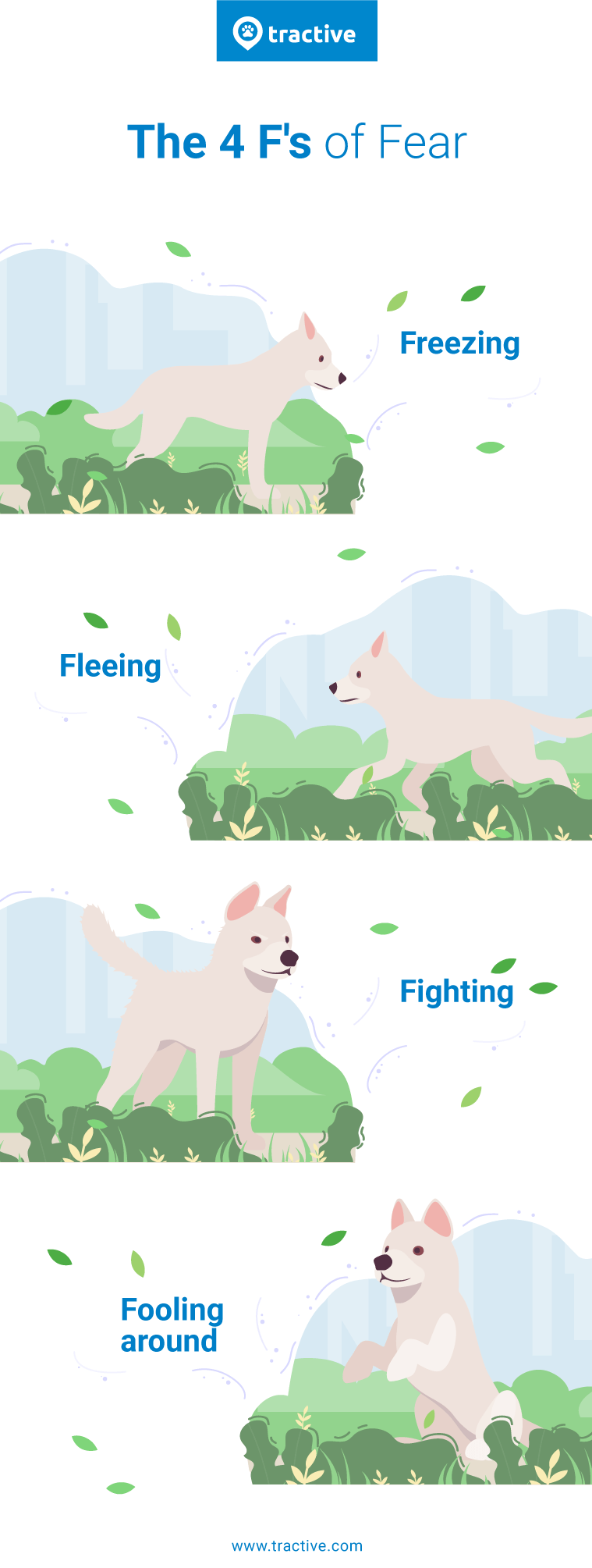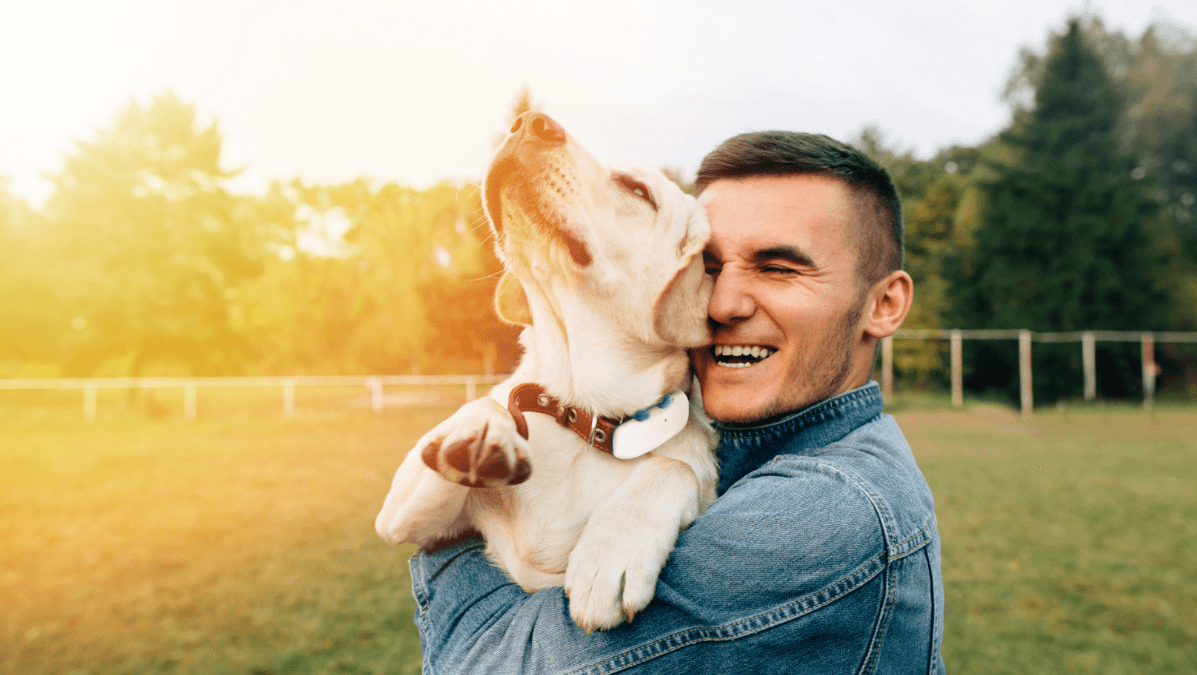Fearful Dog: Our Expert Reveals Everything You Need To Know About Fear In Dogs
Recognizing the signs of fear in dogs is a great start for treating their anxiety. Learn the best tips on how to deal with fearful dogs and what to do if your four-legged friend suffers a panic attack.

Just like humans, dogs can be fearful, shy and anxious (especially if you’ve adopted a shelter dog). Fear and anxiety can be caused by many different factors, but fearful behavior in dogs is most often caused by an early traumatic experience. How can you tell if your dog suffers from severe anxiety and fear? What are the signs and symptoms of fear, and what can you do when your dog feels frightened and panics? We’ve consulted expert Bettina Specht and compiled the most important information below so that you can be informed about fearful dogs.
- Understanding fearful dogs
- Recognizing the signs of fear in dogs
- The 4 F’s of Fear
- Fearful dogs and aggressive behavior
- What to do if your dog panics
- Treating panic and anxiety
- What to do if your dog runs away
- Approaching a lost dog
- Preventing your dog from running away
- Takeaways
- Understanding and training a fearful dog
Understanding fearful dogs
Fear is a natural instinct that protects us by heightening our awareness of potential dangers. Normal fears serve a protective function and keep us safe and secure by making us wary of any potential threat that might come our way. However, fear can also be problematic in cases where it is so severe, that it causes anxiety and/or interferes with your normal life.
It’s important to note that anxiety disorders can affect not only humans, but dogs as well.
Extreme fear and anxiety can occur in dogs for many different reasons. For example, loud noises, storms, fire, and unfamiliar people and places could all trigger fear and anxiety. Fears may also be caused by bad experiences, such as trips to the veterinarian or time spent in boarding kennels.
Recognizing the signs of fear in dogs
It is likely that your dog is experiencing a fearful reaction if he or she displays one or more of the following telltale signs of fear in dogs:
- Shaking or pacing
- Growling, barking, whining, howling or excessive panting
- Wide, open eyes and dilated pupils
- Tail tucked between legs
- Head turned away from the cause of fear
- Ears facing sideways/backwards
- Attempting to “escape” a room or cage to the point of self-injury
- Crouching, slinking, or moving backwards
Take this frightened dog for example, who feels more safe hiding between his mom’s legs when scary strangers approach:
The 4 F’s of Fear
In general, it also helps to be aware of the 4 F’s of Fear, which may be observed in your dog’s behavior:
- Freezing
- Fleeing
- Fighting
- Fooling around
By learning to identify these patterns in your dog’s behavior, you can more quickly determine if your dog is frightened and take the necessary steps to comfort her.
Fearful dogs and aggressive behavior
Destruction and escaping are other behaviors often associated with a scared dog. Fear is a major cause of aggression in dogs and this if often misunderstood, as some people consider any signs of aggression as “bad behavior” which require punishment.
Punishing dogs for fear-based aggression will only make the dog more fearful and aggressive than he or she was before the punishment.
Of course, correcting a dog’s behavior is important when he or she become aggressive, but punishment is not always the proper method of dealing with it, especially if you have a fearful dog on your hands.
What to do if your dog panics
Panic attacks are a symptom of anxiety disorders which usually occur suddenly and without warning. There are no specific triggers so it’s quite unpredictable. A dog panic attack normally lasts about 30 minutes. During this time, the dog isn’t approachable. All you can do is try to be near him or her and make sure that no one gets hurt by their fearful, and potentially aggressive, behavior.
If you touch a dog during a panic attack, he may snap and bite.
Similarly with humans; if a person is drowning, he or she may react by attacking the lifeguard. A leash is a good way to protect your dog so that he or she feels close and secure with you. In case a fearful dog manages to break free, a GPS tracking device for your dog can be a lifesaver.
Treating panic and anxiety
To cope with a fearful dog’s panic or anxiety, it is first necessary to understand the nature of their anxiety, as well as how your pet experiences the anxiety both physically and emotionally. By becoming more aware of what makes your dog fearful and how he is likely to react to fearful stimuli, you’ll be better able to find solutions to help and train your dog in spite of their panicked reactions.
Moreover, it’s important to keep in mind that every dog and reaction is different; there is no one-size-fits-all solution. Find out what comforts your dog in moments of fear — and what doesn’t. Treating a fearful dog requires a lot of time, creativity, patience and empathy.
What to do if your dog runs away
If your dog runs away due to fear, do the following right away:
- Inform your vet, the police, the local animal shelters and your neighbors.
- Inform the national pet register (where your pet is registered).
- Leave the garden and house door open in case your dog manages to come back himself.
- Consider making a Facebook post informing your friends and family that the dog is lost so that they can also share it with members of the wider community.
Approaching a lost dog
If someone else locates your dog, they should do their best to avoid scaring him further or trying to catch him.
Instead, they should contact you so that only you (the trusted owner of the dog) can approach and retrieve him. Whether you are helping someone to find a lost dog, trying to calm a scared dog, or just trying to approach an animal on the street to offer it assistance, knowing the signs of a frightened dog and how to approach it safely can make a world of difference.
Preventing your dog from running away
Despite all of our loving precautions, it is still possible that a scared dog could escape from the house or without knowing better, run away from his or her parents. Even with a leash, safety harness and training, you can’t be 100% sure that your dog won’t escape. For that reason, a GPS tracker is recommended for dogs who are prone to fear and anxiety attacks. With a GPS tracker, the dog can be found quickly, preventing them from coming into harm’s way.
Takeaways
We hope our expert advice has helped you to be better informed about fearful dogs. Just remember:
- Many factors can lead to fearful reactions in dogs.
- It’s important to be able to recognize the signs of fear in your dog.
- Don’t punish dogs for aggressive behavior caused by fear; address the underlying cause.
- Take caution to ensure safety of yourself and others in case of a dog panic attack.
- Learn your dog’s unique fearful stimuli and reactions, to better help them overcome them.
- Take immediate action if your fearful dog runs away.
- Be cautious approaching a lost & unknown dog; avoid inducing more fear.
- Always know where your fear-prone dog is with the help of a Tractive GPS tracker.
Understanding and training a fearful dog
Here are more tips on understanding and training fearful dogs:





